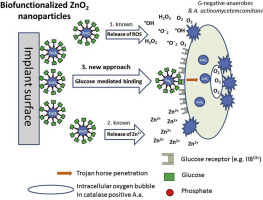Anaerobe ( IF 2.3 ) Pub Date : 2020-01-18 , DOI: 10.1016/j.anaerobe.2020.102153 Katrin Fröber 1 , Christian Bergs 2 , Andrij Pich 3 , Georg Conrads 1

|
For dental implants the accumulation of anaerobic bacteria is a main reason for peri-implant inflammation, which untreated can lead to implant loss. Oxygen releasing substances may act as antibacterial agents. In this study glucose-1-phosphate (Glc-1P) biofunctionalized zinc peroxide (ZnO₂) nanoparticles of four different synthesis ratio (1–10:1) and sizes (4–5 nm) were tested against the anaerobes Fusobacterium nucleatum, Porphyromonas gingivalis, and Prevotella intermedia, as well as against Aggregatibacter actinomycetemcomitans, Enterococcus faecalis, Staphylococcus aureus, Lactobacillus paracasei, and the yeast Candida albicans. Nanoparticles stabilized with o-phosphorylethanolamine, bis[2-(methacryloyloxy)ethyl] phosphate, or dioctyl sulfosuccinate instead of glucose were used as controls. For every combination of test strain and nanoparticle both, the minimal inhibitory (MIC) and minimal microbicidal concentration (MBC or MFC) were determined under different pH conditions in microtiter plates. Furthermore, transmission electron (TEM) and fluorescence microscopy after live-dead-staining was performed on selected combinations of pathogen and nanoparticle in order to visualize the interactions. The ZnO2/Glc-1P nanoparticles had an inhibitory effect on gram-negative anaerobes and on A. actinomycetemcomitans with a pH-dependent MIC ≥25 μg/ml and MBC ≥50 μg/ml, while the gram-positive species tested and C. albicans were not inhibited. In TEM images, attachment of nanoparticle-chains to the bacterial outer membrane and subsequent penetration was found together with an intracellular oxygen release. For nanoparticles with other stabilizers than glucose an invasion was only seen in elongated, dividing cells, possibly because of the more porous cell wall in the parting layer. Decorating ZnO2 by glucose-1-phosphate is a Trojan horse approach to permit their uptake in gram-negative oxygen-sensitive bacterial cells.
中文翻译:

生物功能化的过氧化锌纳米颗粒可抑制种植体周围相关的厌氧菌和聚合酶放线菌pH依赖性。
对于牙植入物,厌氧细菌的积累是植入物周围炎症的主要原因,未经治疗可导致植入物损失。释放氧气的物质可以充当抗菌剂。在这项研究中,针对四种厌氧菌核梭菌,牙龈卟啉单胞菌测试了四种不同合成比(1-10:1)和大小(4-5 nm)的葡萄糖-1-磷酸(Glc-1P)生物功能化过氧化锌(ZnO 2)纳米粒子,中间媒介杆菌以及对付放线杆菌,粪便肠球菌,金黄色葡萄球菌,副干酪乳杆菌和白色念珠菌。用邻磷酸基乙醇胺,磷酸二[2-(甲基丙烯酰氧基)乙基]磷酸酯或磺基琥珀酸二辛酯代替葡萄糖稳定的纳米颗粒用作对照。对于测试菌株和纳米颗粒的每种组合,在微量滴定板中的不同pH条件下测定最小抑菌浓度(MIC)和最小杀微生物浓度(MBC或MFC)。此外,对病原体和纳米颗粒的选定组合进行活死染色后的透射电子(TEM)和荧光显微镜检查,以观察相互作用。ZnO 2 / Glc-1P纳米颗粒对革兰氏阴性厌氧菌和嗜酸放线杆菌有抑制作用,其pH依赖性MIC≥25μg/ ml和MBC≥50μg/ ml,而革兰氏阳性菌则通过白色念珠菌没有被抑制。在TEM图像中,发现纳米颗粒链附着在细菌外膜上并随后渗透,并释放出细胞内的氧气。对于具有除葡萄糖以外的其他稳定剂的纳米颗粒,仅在细长的分裂细胞中才观察到侵袭,这可能是因为分离层中的细胞壁更加多孔。用葡萄糖-1-磷酸酯修饰ZnO 2是特洛伊木马方法,允许其在革兰氏阴性的氧敏感细菌细胞中摄取。


























 京公网安备 11010802027423号
京公网安备 11010802027423号